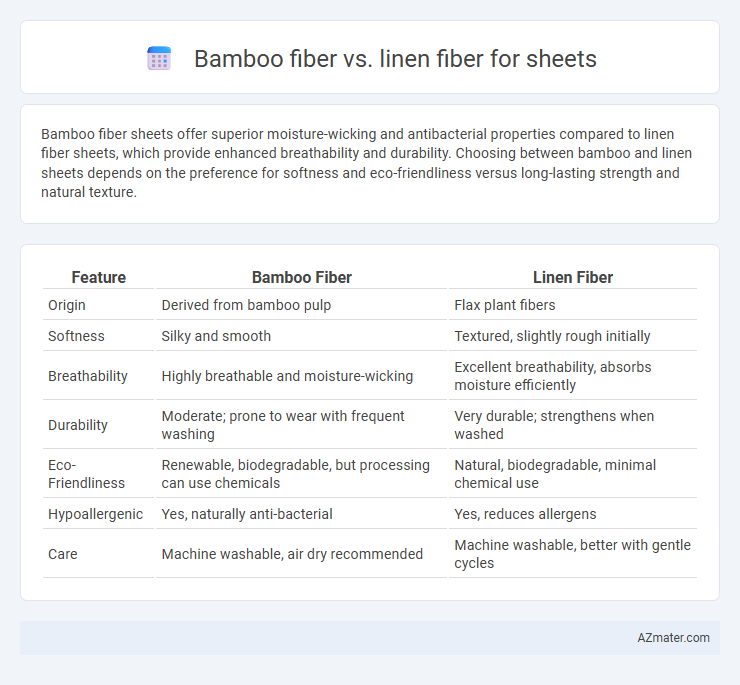Bamboo fiber sheets offer superior moisture-wicking and antibacterial properties compared to linen fiber sheets, which provide enhanced breathability and durability. Choosing between bamboo and linen sheets depends on the preference for softness and eco-friendliness versus long-lasting strength and natural texture.
Table of Comparison
| Feature | Bamboo Fiber | Linen Fiber |
|---|---|---|
| Origin | Derived from bamboo pulp | Flax plant fibers |
| Softness | Silky and smooth | Textured, slightly rough initially |
| Breathability | Highly breathable and moisture-wicking | Excellent breathability, absorbs moisture efficiently |
| Durability | Moderate; prone to wear with frequent washing | Very durable; strengthens when washed |
| Eco-Friendliness | Renewable, biodegradable, but processing can use chemicals | Natural, biodegradable, minimal chemical use |
| Hypoallergenic | Yes, naturally anti-bacterial | Yes, reduces allergens |
| Care | Machine washable, air dry recommended | Machine washable, better with gentle cycles |
Introduction to Bamboo and Linen Fibers
Bamboo fiber, derived from the pulp of bamboo grass, is prized for its natural antibacterial properties, moisture-wicking ability, and eco-friendly cultivation requiring little water and no pesticides. Linen fiber, made from the flax plant, offers exceptional strength, breathability, and a crisp texture that softens with use, backed by centuries of sustainable farming practices and durability. Both fibers are valued in bedding for their comfort and sustainability, with bamboo excelling in softness and odor resistance, while linen provides superior airflow and thermal regulation.
Fiber Sources and Sustainability
Bamboo fiber is derived from the pulp of fast-growing bamboo grass, making it a highly renewable resource with a minimal need for pesticides and water compared to traditional crops. Linen fiber comes from flax plants, which require fewer pesticides and water than cotton but have a longer cultivation cycle, impacting overall sustainability. Both fibers offer eco-friendly alternatives for sheets, with bamboo excelling in rapid renewability and linen in its low-impact agricultural footprint.
Manufacturing Processes Compared
Bamboo fiber sheets are produced through a combination of mechanical crushing and chemical treatment, often involving solvents like sodium hydroxide to extract cellulose and create viscose rayon fibers, which emphasizes sustainability but involves chemical use. Linen fiber manufacturing starts with harvesting flax plants, followed by retting--a natural microbial process that separates fibers--and mechanical scutching, resulting in strong, long fibers with minimal chemical intervention. Bamboo fiber production tends to have a higher chemical footprint than the more eco-friendly, traditional mechanical processing of linen, impacting overall environmental considerations in sheet manufacturing.
Texture and Feel: Comfort Differences
Bamboo fiber sheets offer a silky, smooth texture with natural moisture-wicking and breathability, providing a cool and soft feel ideal for sensitive skin and hot sleepers. Linen fiber sheets present a coarser, more textured surface that softens with use, delivering excellent durability and a breathable, airy comfort perfect for those who prefer a slightly crisp yet natural fabric. Both fibers enhance sleep comfort, with bamboo excelling in softness and linen in textured coolness.
Breathability and Temperature Regulation
Bamboo fiber sheets excel in breathability due to their micro-gaps that allow superior air circulation, reducing heat retention and promoting moisture wicking for a cooler sleep environment. Linen fiber sheets also offer excellent breathability with natural flax fibers that enhance airflow and rapidly absorb moisture, but they tend to feel cooler and more textured compared to bamboo. Bamboo fibers provide a softer feel with temperature-regulating properties ideal for warmer climates, while linen's durability and cooler touch suit those seeking a crisp, breathable fabric for both warm and cool seasons.
Durability and Longevity
Bamboo fiber sheets offer moderate durability with natural antimicrobial properties that resist wear and tear over time, while linen fiber sheets are renowned for exceptional strength and increased longevity due to flax fibers' inherent resilience. Linen sheets tend to become softer with each wash without compromising durability, maintaining structural integrity for years, whereas bamboo sheets may show signs of wear faster under frequent use. Choosing linen fiber ensures long-lasting sheets with high durability, whereas bamboo fiber provides comfort and sustainability with moderate lifespan.
Moisture Wicking and Absorption
Bamboo fiber excels in moisture wicking and absorption, drawing moisture away from the skin and drying quickly, making it ideal for hot sleepers. Linen fiber also offers strong moisture absorption and breathability, but it dries slower compared to bamboo, resulting in a cooler, but slightly damp feel under high humidity. Both fibers promote comfort, but bamboo is superior in managing moisture for a consistently dry sleep environment.
Hypoallergenic and Antibacterial Properties
Bamboo fiber sheets exhibit strong hypoallergenic and antibacterial properties due to the presence of natural bio-agents like bamboo kun, which inhibits bacterial growth and reduces allergens. Linen fiber sheets, derived from flax plants, are naturally hypoallergenic and breathable but lack inherent antibacterial compounds compared to bamboo. Choosing bamboo fiber sheets benefits individuals with sensitive skin or allergies by offering enhanced antimicrobial protection and moisture-wicking capabilities, while linen provides durable, breathable comfort with mild allergen resistance.
Environmental Impact and Eco-Friendliness
Bamboo fiber sheets are highly sustainable due to bamboo's rapid growth and minimal water requirements, making them an eco-friendly choice with low environmental impact. Linen fiber, derived from flax plants, also offers significant environmental benefits such as biodegradability and low pesticide use, but flax cultivation demands more water compared to bamboo. Both fibers provide biodegradable, renewable options, yet bamboo's faster growth cycle and efficient resource use often give it an edge in eco-friendly bedding production.
Price and Value Comparison
Bamboo fiber sheets typically offer a more affordable price point compared to linen fiber sheets, making them a popular choice for budget-conscious consumers. While linen sheets tend to be more expensive due to the labor-intensive harvesting process and durability that improves with age, they provide long-term value through increased strength and breathability. Bamboo fiber sheets deliver excellent moisture-wicking properties and softness at a lower cost, offering a balance of comfort and value for everyday use.

Infographic: Bamboo fiber vs Linen fiber for Sheet
 azmater.com
azmater.com